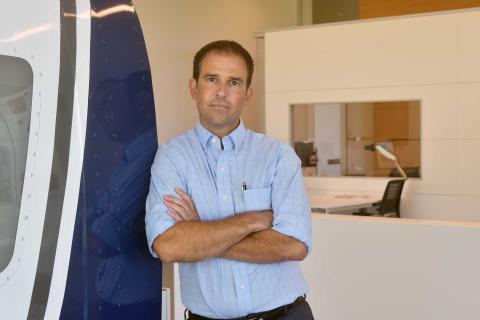Thirty years ago, D. Todd Smith, PhD, loaded a crash victim into a medical helicopter and helped the flight nurse manage the patient’s airway with an endotracheal tube. It was at that moment—thousands of feet above the ground—that Smith found his footing in flight nursing.
Throughout his career, Smith, an Adult Gerontology Acute Care Nurse Practitioner, has been a firefighter, EMT and a flight nurse for hospitals and private-air ambulances. Since fall 2019, he’s led the Dorothy Ebersbach Academic Center for Flight Nursing at the Frances Payne Bolton School of Nursing—training nurses and other medical professionals to provide patient care and transport in helicopters and fixed-wing aircraft.
Forefront talked with Smith, an assistant professor at the nursing school, to discuss his plans for the center and his passion for the high-flying field.
Besides the obvious difference of being airborne, what sets flight nursing apart?
Smith: It’s knowing how to take care of the most unstable critical care patient at 3,000 feet in the air, in the dark, wearing night-vision goggles and hoping the helicopter doesn’t hit a guide wire or a tree branch, or that nothing happens to the pilot that would cause the helicopter to plummet out of the sky.
But is airborne care all that different?
Smith: The logistics are complex, but the patient care is relatively straightforward.
What special skills do flight nurses need?
Smith: [Nurses] may be amazing in the intensive care unit or emergency room, but when you put them in the snow at night on a country road with a patient in a ditch, having to get that patient on board and take off in 10 minutes—it’s not for everyone.
What are the tensest moments?
Smith: Takeoff and landing. No one talks and it’s everyone’s job—including the flight nurse’s—to ensure there are no obstructions. It’s all of our jobs not to die. That’s the hard reality.
You became leader of the Dorothy Ebersbach Academic Center for Flight Nursing last fall. What are your plans for the center?
Smith: My goal is to increase the number of students who go through the program. We’ve evaluated the entire program and are developing a proposal to exponentially increase access and develop a new simulation center with the latest technology.
The center has a helicopter simulator in Samson Pavilion at the Health Education Campus with Cleveland Clinic. Tell us about that.
Smith: It’s the fuselage of a retired Sikorsky S-76 [helicopter], and it’s the only one of its kind in the country. It’s got room inside for five people and … does a good job of simulating flight. The simulator moves and the views projected on the windows make it seem like it’s airborne. It’s a valuable tool.
What do you love about being a flight nurse?
Smith: I like being outside the hospital, and I enjoy working with the paramedics and firefighters at accident sites and the doctors at the rural hospitals where we typically pick up patients. Even though you might interact with them for only a few minutes, you quickly form a team that’s all about providing the best care for the patient and ensuring everyone’s safety.
—Jim Sweeney


